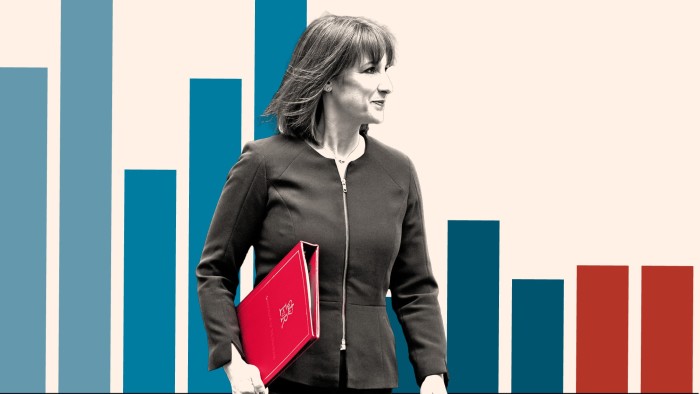Rachel Reeves insists she has put the UK public finances on a stable footing. But the government’s fiscal watchdog on Wednesday made clear how easily the chancellor could get knocked off balance.
The chancellor’s Spring Statement left her with a £9.9bn margin of error against her “non-negotiable” fiscal rule requiring her to balance the current budget by 2029-30 — the third-slimmest room for error since 2010.
“The array of potential claims on that small amount of headroom is large and varied,” warned OBR chair Richard Hughes, giving Reeves no more than a 50 per cent chance of meeting her targets.
“The risks to the outlook for UK productivity, interest rates and global tariffs could all reduce it back to zero.”
The £14bn fiscal repair job that Reeves undertook on Wednesday was never meant to happen in the first place. Last year she vowed to only hold one major fiscal event each year, but she left in place a requirement for the OBR to deliver forecasts in both the spring and autumn.
Higher than expected borrowing figures and rising debt interest costs pulled the Treasury into a £4.1bn shortfall against the key current budget rule based on the OBR’s new forecast.
Reeves corrected course with a combination of welfare cuts, a tax-avoidance crackdown, and a squeeze on day-to-day departmental spending.
But the chancellor remains in perilous fiscal waters. Underlying public sector net debt is projected to carry on rising until the end of the parliament despite the spending cuts, reaching 95 per cent of GDP in 2029-30, compared with 89 per cent currently according to the OBR.

That comes even as the tax take is set to rise to a postwar high at 37.7 per cent of GDP in 2027-28, the OBR said. Total public spending is set to rise to 45 per cent of GDP in 2025-26 before later cuts start to take effect, and will still be 4.2 per cent of GDP above its pre-pandemic level in 2029-30.
The OBR pared back its near-term growth forecast from 2 per cent to 1 per cent this year. It assumes GDP growth will rebound later in the parliament, helped by favourable estimates of the impact of Labour’s planning reforms.
Reeves enthusiastically seized upon that predicted recovery on Wednesday, but as with many of the other assumptions underpinning the UK’s fiscal outlook, economists warned it could quickly dissolve on contact with harsh economic reality.
Andrew Wishart of Berenberg called the growth figures “strikingly bullish”. David Page, chief economist at Axa Investment Management, also questioned the “rosy” forecast, warning the Spring Statement was “unlikely to prove the last word on efforts to restrain the public finances.”
Markets greeted the Spring Statement calmly, with the pound stable, while 10-year gilt yields closed down 0.025 percentage points to 4.73 per cent, as the price of the debt rose. This marked a big contrast with the October Budget, where plans for higher than anticipated borrowing contributed to a sell-off in gilts.
Nevertheless, said Matthew Morgan, head of fixed income at Jupiter Asset Management, Reeves’ statement represented “a kick-the-can exercise”, with the UK’s public finances remaining “very challenged”.
One of the single biggest risks to the fiscal outlook is the OBR’s judgment on productivity, a key determinant of the UK’s fiscal fortunes.
Productivity has been inexplicably weak over the past two years and there remains a real danger that it could fail to pick up as much as the OBR currently forecasts.
The OBR has over the past 10 years lowered its medium-term productivity growth assumption from about 2.2 per cent to 1.25 per cent. Uncertainty around that productivity assumption “remains high”, the OBR warned.
If annual growth in output per hour worked stayed at its current rate of 0.3 per cent over the five-year forecast period, the current budget would end the decade in deficit by about 1.4 per cent of GDP, with Reeves missing her fiscal target by £48bn.
A relatively small rise in global interest rates could also wipe out her headroom, as could an escalation in trade tensions. If the US extended its 20 percentage point tariff increase to all goods imports, the hit to growth and increase in inflation-linked government spending would “virtually eliminate” headroom against the current budget rule by 2029-30, the OBR said.
The fiscal and economic gains from the policy measures Reeves has set out were also highly uncertain, the OBR said, especially when it came to welfare reforms where the government had not given enough details of its policies.
It was not yet clear how many people would be helped by new job support programmes, or whether new spending on defence would be spent on UK-produced equipment or overseas. And the OBR made no attempt to assess whether the government’s intended upgrade of workers’ rights, or its deregulation drive, would boost growth.
The OBR also said “huge uncertainty” around the effects of welfare reforms, and the fact that the government had not yet said how it would fund its ambition to raise defence spending to 3 per cent of GDP, compounded the risks to the fiscal outlook.
Reeves is also heading into a tough departmental spending settlement in June. Real-terms spending on unprotected government departments such as the Home Office may need to be cut by 0.8 per cent a year from 2026-27 to accommodate commitments in other areas like the health and defence, according to the OBR.
And while Reeves insisted she was determined to deliver on the UK’s “vital commitments on defence”, her spending boost to 2.5 per cent of GDP may well prove just a downpayment given pressure from the US for Europe to stand on its own feet militarily.
“There is an air of unfinished business here,” said Paul Dales at Capital Economics. “Reeves said the world is changing, but fiscal policy hasn’t changed much at all. It is a bit of tinkering that points to big changes coming down the line.”
Additional reporting by Ian Smith in London








